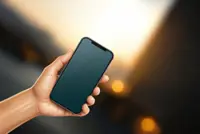The modern phone seems to never stop vibrating, pinging and lighting up in an unending quest for our attention. Short of turning the phone off and rendering it a useless brick, there’s little one can do to get distance from a device. That’s where Do Not Disturb mode comes in. — Photo by Elijah Fox on Unsplash
Annie Wu Henry hasn’t gotten a notification on her phone in two years. Calls go straight to voicemail. Apps vibrate their updates into the ether. Texts pile up silently. Same with emails. They have to wait until she decides to look at her device next.
That’s because of Do Not Disturb mode, a phone setting that acts as a modern-day away message for smartphone users, cautioning those who contact you that you’re likely to take a while to return their messages.
“It’s expectation-setting,” said Henry, a 28-year-old digital strategist who worked to elect Sen. John Fetterman, D-Pa. “If I don’t get to it, it’s not personal. I’m just busy.” (She noted that she had notifications on when she was managing his social media during the 2022 campaign – but only then.)
“If it’s important, they will send the message or try to make the call or get in touch with me in one way or another,” she continued. “And if it’s not, maybe it’ll just give them a second to think about if it’s actually important.”
The modern phone seems to never stop vibrating, pinging and lighting up in an unending quest for our attention. Short of turning the phone off and rendering it a useless brick, there’s little one can do to get distance from a device. That’s where Do Not Disturb mode comes in.
When the setting is enabled on an iPhone, any would-be texters see a disclaimer that the person they are trying to contact has notifications silenced. Beneath that is a tempting offer: “Notify Anyway.” If clicked, the notification will go through as it normally would, but the message seems clear enough: Don’t expect an answer, at least not right away.
Apple introduced Do Not Disturb in 2012 – with other smartphone operating systems following suit not long after – but the use of the setting seems to have become more popular lately, as people seek more measures to limit screen time or ditch their devices altogether. After more than a decade of smartphones, some of us are jumping at the chance to establish boundaries.
“Phones are built for addiction,” said Sean Grover, a psychotherapist in New York. “And like anything that’s an addictive substance, you need to contain it. You need to have a structure around it.”
Grover sees Do Not Disturb as the virtual version of the signs that people can choose to hang outside their hotel doors. “It’s like putting a hand up and saying, ‘Don’t enter’,” he said. “I like the firmness of that.”
But once it goes up, it can be hard to take down. Like Henry, some say they switched on the mode long ago and may never turn back – occasionally to the frustration of their friends.
“I understand if someone is sleeping or busy, but if it’s on all the time, it functions like a locked door and a ‘Go Away’ doormat,” said Katriel Nopoulos, a 35-year-old disability activist in Philadelphia. “It’s the opposite of hospitality and welcoming.”
And that is often the point. Zoe Marzo, 36, said she first enabled Do Not Disturb when a friend wouldn’t stop texting her. “It was incessant,” she said. “So I kind of started using it as an extra defence and boundary. Now I have it on all the time.
“There’s an assumption that because we have our phones with us all the time, there is an entitlement to people’s time,” Marzo, a doctoral student who is researching the use of technological devices in everyday life, added. “We need to have our own personal space.”
Nicholette Leanza, a clinical counselor in Ohio, said the use of Do Not Disturb can be a way of navigating the feeling of being stretched too thin by the demands of life – which often arrive in the form of infinite phone notifications. But if patients have Do Not Disturb on all the time, she would want to explore why they felt the need to be constantly unreachable.
“For some people, it is avoidance,” she said. “It’s ‘I don’t want to be connected at all, to anyone’. So I would have them dive deeper, like what’s that about? When you’re isolating yourself, that could be indicative of other stuff going on, too.”
Henry said there have been some downsides of the setting – she often misses the notifications from the app BeReal, which prompts users at a different time once a day to snap a photo of what they’re doing. And once, she missed an email for a job she had applied to asking her to interview. By the time she saw the notification, the job had been filled.
But for the most part, she appreciates that the feature buys her some time to respond to the many demands on her attention. Despite these hiccups, she says she’s sticking with it.
“I think it just gives me a little grace,” she said. – The New York Times





